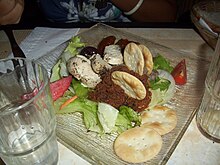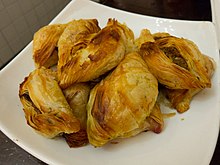In Malta Over the centuries, the influences of Mediterranean, Oriental and, most recently, British cuisine resulted in a successful combination that offers both familiar and interesting. Rabbits and everything the sea has to offer are popular, first and foremost the golden mackerel. Beer is drunk, their own wine is produced and Kinnie is the special Maltese lemonade.
Appetizers
- Maltese platter is a starter platter that differs from restaurant to restaurant. Common ingredients are sausage slices, goat cheese, bigilla, dried tomatoes, capers, olives, lettuce, tomatoes, onions and much more. There is also bread or salt crackers.

Maltese platter

in many
Executions
dishes
- Bigilla is a paste made from beans and garlic as a spread. White beans are made into a paste with butter, garlic, salt, pepper and parsley.
- Torti are called the Maltese pies. They are available with different fillings. Traditionally they are filled with ricotta, eggs and parsley, but also with bacon, peas or, in spring, with broad beans.
- Timpana are macaroni with minced meat sauce in a dumpling pocket. They are sometimes made with veal brain, liver, fried eggplant, bechamel sauce, or with hard-boiled eggs.
- Ravjul are similar to ravioli, they are often filled with Gozitan Ġbejna (young sheep or goat cheese). There is also tomato sauce.
Timpana

Ravjul
- Pastizzi are filled puff pastry pockets
- Qassata are filled tarts. Qassatat Ta'l-Irkotta are filled with ricotta cheese, Pizelli with peas or with spinach and anchovies.
- Ross fil-forn (Rice from the oven) is a rice dish with a sauce made from minced meat, tomatoes, eggs and saffron, which is cooked slowly over a low flame.
- Hobz biz-zejt is a sourdough bread that is topped with combinations of onions, capers, garlic, olives, tomatoes, tuna, mint or anchovies and then drizzled with olive oil.
- Brungiel mimli are eggplants stuffed with meat, olives and capers.
- Kapunata is a braised vegetable dish made from tomatoes, green pepper, eggplant and garlic, similar to ratatouille. It is served as a side dish or appetizer.

Pastizzi

Hobz biz-zejt
Qassatata in Valletta
flesh
- Fenek or Fenek stuffat is rabbit baked, roasted or braised in red wine, always with lots of garlic. Rabbit has been a delicacy on the islands for centuries.
Fenek - rabbit stewed in wine with garlic

Fried Rabbit - fried rabbit
- Bragjoli is a beef roulade cooked in red wine and filled with ham or bacon, egg, olives and herbs.
- Kirxa Tripe are usually served as a stew with vegetables
- Laħam taz-ziemel is horse meat
- Bebbux are snails in a garlic sauce
- Fritturi tal-moħħ is fried lamb or veal brain with eggs, garlic and parsley
Soups and stews
- Stuffat are called stews in Malta. They are rich and mostly based on a tomato sauce. Pork or rabbit is used for meat stews. But there is also octopus stew, Stuffat valley Qarnit, made from octopus with boiled vegetables, potatoes and fennel.
- Soppa Tal-Armla (Widow soup) is a bean soup with a little round Gbejna (Cheese made from sheep or goat milk).
- Minestra is a vegetable soup.
- Soppa Tal – Quarha Hamra is a pumpkin soup.
- Kusksu is a traditional Maltese soup made mainly from seasonal fava beans, small pearl noodles and fresh ġbejniet. Although similar in shape, the tiny noodle beads known locally as kusksu are often confused with couscous.
.jpg/220px-Traditional_Maltese_Kusksu_(Fava_Bean_Soup).jpg)
Kusksu with ġbejniet
fish
It is best to eat the freshly caught fish. Squid rings and shrimp are often imported frozen, which can also be eaten at home. The golden mackerel (Coryphaena hippurus), Lampuki called, is considered the national fish that adorned the 10 cent coin of the former Maltese lira. The fishing season for Lampuki is from mid-August to the end of December. In the fishing village Marsaxlokk you will find numerous good fish restaurants at the fishing port and the fish market takes place there every Sunday.

The fish market in Marsaxlokk

with a wide range of fresh fish.
.jpg/220px-Is-Suq_Valletta_Fish_Display_(2).jpg)
Fish and seafood in Valletta
- Aljotta is a spicy fish soup with garlic, pepperoni, tomatoes, rice and chopped parsley or marjoram. Traditionally a summer dish, it was served when fishermen used to be able to go out to sea.
- Qarnita stuffat, also Octopus Stew, is a squid ragout with onions, olives, nuts, raisins and peas in a white wine sauce.
- At Sea Urchin Pasta it is pasta with sea urchins, often with garlic in a tomato sauce.
.jpg/220px-Octopus_stew_Marsaxlokk,_Malta_(2).jpg)
Qarnita stuffat - Octopus Stew

Aljotta
Sea Urchin Pasta - Spaghetti with Sea Urchin
- Lampuki is a casserole with fillet of golden mackerel, spinach, cauliflower, chestnuts and raisins.
- Cartoccio is fillet or whole fish with onions, tomatoes, capers, garlic, lemon and white wine steamed in foil.
- Bakkaljaw is salted stockfish. It is prepared as a stew, fricassee or snifeg, among other things
Sweets
- Kannoli are deep-fried dough rolls filled with chocolate, sweet ricotta and candied fruits, or dried fruits and nuts
- Kwareżimal is a kind of gingerbread, freshly made, sweeter and softer, is made from hazelnuts, almonds, honey and Maltese spices.
- Qagħaq tal-għasel is a pastry ring filled with honey and almond or beet syrup

Kannoli

Kwareżimal

Qagħaq tal-għasel
- Sfineg ta ’San Guzepp are fried dough balls filled with sweet ricotta and coated in honey.
- Mqaret or Imqaret are dumplings filled with a dark aniseed date mixture and fried in oil.
- Pudina tal-hobz is a bread pudding with carob syrup
- Prinjolata is a carnival cake made from biscuit and candied fruit.
- Figolli are almond biscuits filled with marzipan and covered with icing. This specialty is available at Easter.
.jpg/220px-Figolli_Marsaxlokk_Street_Market_(1).jpg)
Figolli
- Sinizza are sweet pastries filled with ricotta and candied fruit
- Torta tal-Marmurat is a cake with almond filling, chocolate and icing
- Ħelwa tat-Tork is a paste made from sweetened, crushed sesame seeds.
- Qubbajt is similar to Turkish honey. In flavors from nut to orange, it is cut from large blocks.
There will also be a large selection of different in the cafes cake offered.

Lemon Cheesecake

Orange and almond cake

Date cake with walnut
ingredients
loaf
The Maltese are proud of their bread (Hobz). There are still many small bakeries that bake according to their own recipes, some even in stone wood ovens. It is traditional bread, a part of the dough from the previous day, a kind of sourdough, is used and then baked dark. It's crispy on the outside and fluffy on the inside. The bread is baked and bought up to three times a day so that it can be enjoyed fresh and warm.
- Ftira is a round, flat loaf of bread with a central hole. Ftira is topped with tomatoes, anchovies, eggs or capers.
- Hobs-biz-time means Bread with oil. It's a crusty bread, coated with oil and tomatoes or tomato puree, topped with tuna, olives, lettuce, capers or even more.
Ftira bread
Ftira with tuna
cheese
- Ġbejna, the plural is ġbejniet is the most famous cheese from Malta. It is a small cheese made from pasteurized or fresh sheep or goat milk. It can be eaten fresh, but it is also available marinated, air-dried or sprinkled with coarse pepper. The cheese is also used to fill ravioli and pastizzi
Gbejniet
beverages
Wine
Wine is an integral part of Maltese culture with over 2000 years of experience in wine production. Some of the larger wineries offer tours of their cellars, and typical grape varieties are the red ones Ġellewza or the white one Għirgentina. What is important is that on the label grown in Malta only then can you be sure that the grapes were harvested on Maltese soil.
- 1 Marsovin, Renfrew, Raħal Ġdid. Tel.: 356 2366 2445. offers a tour of the wine cellar with a wine tasting.
- Meridiana is a smaller winery. Wine cellars and vineyards can be visited.
- Delicata is Malta's most awarded winery.
- Ta ‘Mena Estate in Xaghra in Gozo
beer
The most popular beer on the island is Cisk, a bottom-fermented lager. It comes from the brewery Simonds Farsons Cisk, which offers more beers and drinks on the market.
Schnapps and liqueurs
- Limuncell is similar to Italian limoncello and is made from lime.
- Bajtra is a liqueur made from the fruits of the prickly pear with 20-25% vol.
- Tamakari is a herbal liqueur
Soft drinks
- Kinnie is a carbonated soft drink with a tart taste made in Malta. The main ingredients are unpeeled bitter oranges, as well as anise, ginseng, wormwood and other aromatic herbs.
- Ruġġata is similar to Italian almond milk (Latte di Mandorla), a mixture of almonds, vanilla and sometimes cloves.

Kinnie
- Maltese Coffee is served strong and aromatic in a small cup. Often it is also flavored with cloves and rose water.
Culinary calendar
Culinary delights are often seasonal. Fruits and vegetables are tastier when they are ripe; meat and fish are also subject to seasonal influences. Every season of the year, festivals are celebrated that have a general theme or focus on certain foods. There are also drinking and eating habits throughout the year that arose from religious traditions such as fasting times.
January
February
March
April
- The Festa Frawli, Strawberry Festival, takes place at the beginning of April on the village square in front of the parish church in Imġarr instead of. There are countless products made from strawberries, from chocolate cakes and cakes, to smoothies, milkshakes, ice cream cones, pancakes, strawberry jams and strawberry wines,
May
June
July
- Farsons Great Beer Festival takes place at the end of July for 10 days
August
- L-Imnarya is the feast of St. Peter and St. Paul on June 29th. In Buskett you can try traditional delicacies at the stalls and some farmers and small producers offer their goods.
- From August 15th it is fishing season for Lampuki
September
- Lampuki season
October
- Lampuki season
- At the Qormi Bread Festival celebrate the people of Qormi the bread. You can watch the loaves being prepared and baked in traditional wood ovens. Then you can try the crispy warm bread.
November
- Lampuki season
December
- Lampuki season
literature
Recipes
- Maltese cookbook - Malta-Tours.de - a pdf with almost 70 pages with Maltese recipes.











.jpg/220px-Traditional_Maltese_Kusksu_(Fava_Bean_Soup).jpg)


.jpg/220px-Is-Suq_Valletta_Fish_Display_(2).jpg)
.jpg/220px-Octopus_stew_Marsaxlokk,_Malta_(2).jpg)





.jpg/220px-Figolli_Marsaxlokk_Street_Market_(1).jpg)







